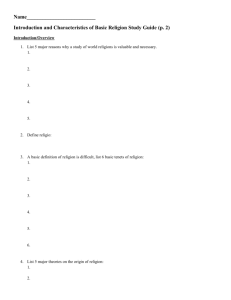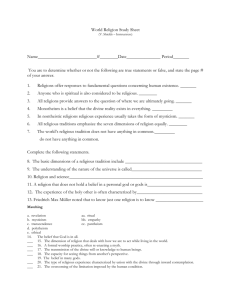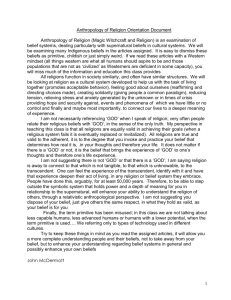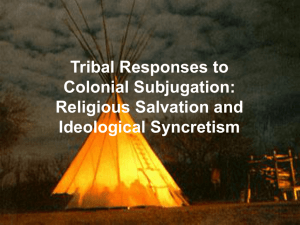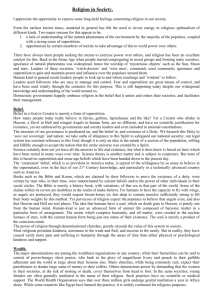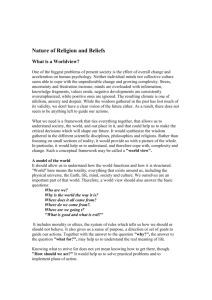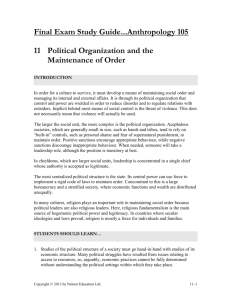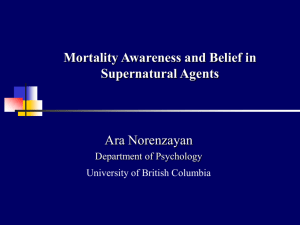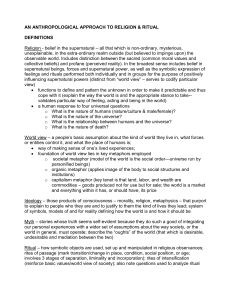Chapter 17 - Religion (Word Doc.)
advertisement
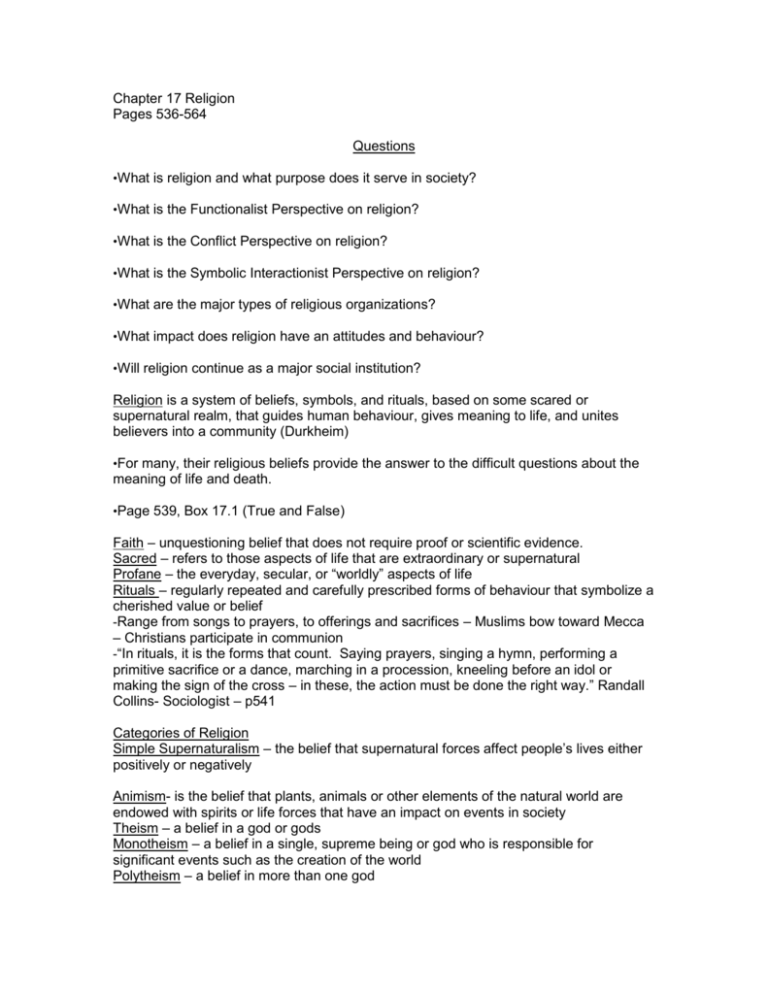
Chapter 17 Religion Pages 536-564 Questions •What is religion and what purpose does it serve in society? •What is the Functionalist Perspective on religion? •What is the Conflict Perspective on religion? •What is the Symbolic Interactionist Perspective on religion? •What are the major types of religious organizations? •What impact does religion have an attitudes and behaviour? •Will religion continue as a major social institution? Religion is a system of beliefs, symbols, and rituals, based on some scared or supernatural realm, that guides human behaviour, gives meaning to life, and unites believers into a community (Durkheim) •For many, their religious beliefs provide the answer to the difficult questions about the meaning of life and death. •Page 539, Box 17.1 (True and False) Faith – unquestioning belief that does not require proof or scientific evidence. Sacred – refers to those aspects of life that are extraordinary or supernatural Profane – the everyday, secular, or “worldly” aspects of life Rituals – regularly repeated and carefully prescribed forms of behaviour that symbolize a cherished value or belief -Range from songs to prayers, to offerings and sacrifices – Muslims bow toward Mecca – Christians participate in communion -“In rituals, it is the forms that count. Saying prayers, singing a hymn, performing a primitive sacrifice or a dance, marching in a procession, kneeling before an idol or making the sign of the cross – in these, the action must be done the right way.” Randall Collins- Sociologist – p541 Categories of Religion Simple Supernaturalism – the belief that supernatural forces affect people’s lives either positively or negatively Animism- is the belief that plants, animals or other elements of the natural world are endowed with spirits or life forces that have an impact on events in society Theism – a belief in a god or gods Monotheism – a belief in a single, supreme being or god who is responsible for significant events such as the creation of the world Polytheism – a belief in more than one god Nontheistic Religion – a religion based on a belief in divine spiritual forces such as scared principles of thought and conduct, rather than a god or gods. Sociological Perspective on Religion Functionalist Perspective Durkheim on Religion – religion is essential to the maintenance of that society – religion was a cultural universal found in all societies because it met basic human needs & served important societal functions -the central feature of all religions is the presence of scared beliefs and rituals that bind people together in a collectively -He suggested that the correct performance of the ritual gives rise to religious conviction Collective Representations – group held meanings that express something important about the group itself Functions of Religion •Providing meaning and purpose to life •Promoting social cohesion and a sense of belonging •Providing social control and support for the government Meaning and Purpose -Religion offers meaning for the human experience -Some events create a profound sense of loss on both an individual basis (such as injustice, suffering, and the death of a loved one), and a group basis (such as famine, earthquake, economic depression, or subjugation by an enemy) -Even offers hope of an afterlife for persons who follow the religion’s tenets of morality in this life Social Cohesion and a Sense of Belonging -Emphasizing shared symbolism, religious teachings and practices help promote social cohesion -All religions have some forms of shared experience that rekindle the group’s consciousness of its own unity. Social Control and Support for the Government -All societies attempt to maintain social control through systems of rewards and punishments -Sacred symbols and beliefs establish powerful, pervasive, long-lasting motivations based on the concept of general order of existence -Maintains social control in society by conferring supernatural legitimacy on the norms and laws in society -In some societies, social control occurs as a result of direct collusion between the dominant classes and the dominant religious organizations The Conflict Perspective on religions – Karl Marx (Macro Level) -Ideologies “systematic views of the way the world ought to be” are embodies in religious doctrines and political values -Ideologies serve to justify the status quo and to inhibit social change -Marx wrote religion was the “opiate of the masses” – they become complacent – they are taught to believe in an afterlife and they are rewarded for their suffering and misery in this life -Religion unites people under a “false consciousness” – they believe they have common interests with members of the dominant class -Religion promotes strife between groups and societies - within a religious group, or between a religious group and the larger society Max Weber’s Response to Marx -Marx believed that religion inhibited change - Weber argues just the opposite – religion could be a catalyst to produce social change -Predestination – the belief that, even before they are born, all people are divided into two groups, the saved and the damned -Believed that religion reinforced existing social arrangements – especially the stratification system -The wealthy used religion to justify their power and privilege – sign of God’s approval of their hard work and morality -The poor believe that if they work hard and live a moral life, they will be richly rewarded in another life Symbolic Interactionist Perspective on Religion (Micro Level) Religion as a Reference group - helps individuals to define themselves – religious symbols have meaning for many people -Examples – Star of David significant for Jews – Crescent Moon and Star significant for Muslims – Cross significant for Christians -A symbol may have a certain meaning beyond that shared by the group -Symbolism of religion is so very powerful because it “expresses the essential facts of out Religious Conversion -Why do people convert to non-traditional religious movements First three steps – predisposed potential converts to join the group – Last four steps – situational factors that led to successful conversion -Some important tension or strain in their lives (financial problems, marital issues, sexual identity problems, issues around mental and physical disabilities -A religious problem –solving perspective -Their self-definition as religious seekers who actively sought to resolve their problems through some system of religious meaning -People come to a turning point in their lives – dropped out of school or they lost a job -Affective ties with members of the “new” religion -Reduction in ties with people outside the group -Exposure to very intensive interaction with other group members Feminist Perspectives on Religion -His Religion and Her Religion – women have less influence on establishment of social definitions of appropriate and in the larger community -Religious symbolism and language typically create a social definition of the roles of men and women Women in the Ministry -Gender inclusiveness of Christianity and Judaism and the absence of women in significant roles within religious institutions -Women are demanding an end to the traditions that do not reflect their historic role and their ongoing stake in the divine Types of Religious Organizations Ecclesia – a religious organization that is so integrated into the dominant culture that it claims as its membership all members of a society The Church – Sect Typology Church – is a large, bureaucratically organized religious body that tends to seek accommodation with the larger society in order to maintain some degree of control over it Denomination – a large organized religion characterized by accommodation to society but frequently lacking the ability or intention to dominate society Sect – is a relatively small religious group that has broken away from another religious organization to renew what it views as the original version of the faith Cults/New Religious Movements Cult – is a religious group with practices and teachings outside the dominant cultural and religious traditions of a society -Cults are a result/response to several kinds of cultural and social change •Changes in values •Changes in social structure •Changes in the role and character of religious institutions Trends in Religions in Canada Religiosity – is Canada a religious society? Depends ….. Liberation Theology – the Christian movement that advocates freedom from political subjugation within a traditional perspective and the need for social transformation to benefit the poor and downtrodden Religion in Canada 2000 + “Religion has become a smorgasbord for Canadians” (Dr. Nancy Nason-Clarke) – in other words, religion is a buffet where Canadians pick and choose what they want from religion – I’ll take a church wedding but I don’t want the no premarital sex dish - I’ll take the funeral service, but I don’t believe in hell, and so on…..
